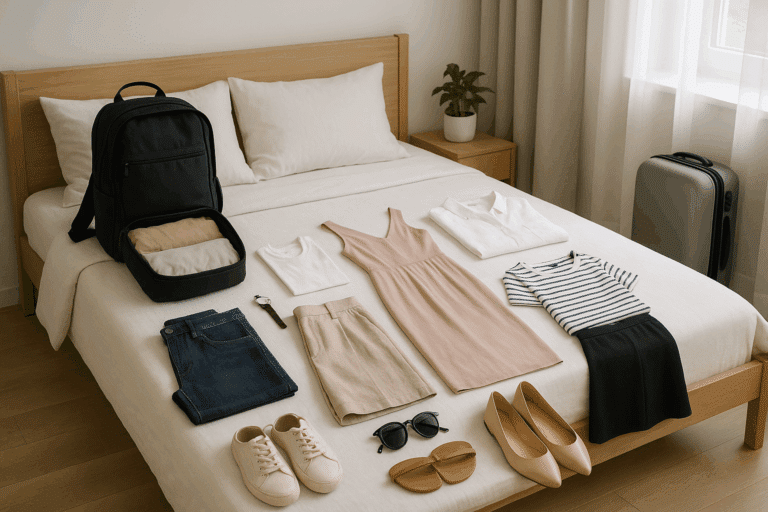Sounds impossible? In this modern era, where the push for sustainability is higher than ever, reusing clothes and accessories has become a hot topic. It’s not just about reducing waste or saving money anymore; it’s about showing off your personal style and creativity.
The challenge, however, lies in how to reuse clothes without repeating photos, especially when you’re someone who likes to post on social media frequently or if you’re a professional in the fashion industry. Whether you’re a model, a blogger, or simply a fashion enthusiast, the pressure to present a continuous flow of unique outfits can be overwhelming.
This article aims to solve that very conundrum. We’ll dive deep into the art of reusing clothes without letting your photos get monotonous. We’ll discuss the art of mix and match, the role of accessories, the importance of different photography angles, and even the magic of editing software. By the end of this reading, you’ll be equipped with an arsenal of tricks to keep your style fresh and intriguing, while being resourceful with your wardrobe.
So, how do we achieve the goal of ‘Fresh Looks Every Time: How to Reuse Clothes Without Repeating Photos for Endless Style’? It’s not as daunting as it sounds, and it’s definitely not about buying new clothes every other day. Rather, it’s about changing our perspective, embracing creativity, and breaking free from the shackles of conventional fashion rules.
Let’s start by talking about the art of ‘mix and match’. How do you combine different pieces to create a new look? Can the same shirt be a part of a casual day look and an elegant evening outfit? How many unique outfits can you create from a set number of clothing items? We’ll explore all these questions, providing you with the right techniques to master the game of mix and match.
But that’s just the beginning. Next, we’ll delve into the world of accessories. Accessories can be game-changers when it comes to reusing clothes for fresh looks. A single scarf can be styled in multiple ways; a statement necklace can change the vibe of an outfit, and the right pair of shoes can be the perfect finishing touch. We’ll help you understand how to make the most out of your accessories and how to use them to create a diverse range of looks from the same clothes.
Now, what about photography? Yes, the way you take your photos can also make a significant difference. The same outfit can look vastly different under different lighting conditions, from different angles, or in different locations. Even the poses you choose can change the overall aesthetic of the photo. We’ll provide you with the essential photography tips to ensure that your photos always look fresh and unique, even if you’re reusing the same clothes.
And last but not least, we’ll touch upon the role of editing software. Sometimes, a little tweaking here and there can turn a regular photo into a masterpiece. A change in the color palette, a little cropping, some added filters – the possibilities are endless when you have the right tools and know how to use them.
By the end of this article, reusing clothes without repeating photos will no longer seem like an insurmountable challenge, but a fun and creative process. So, let’s embark on this fashion journey together, aiming for endless style, one reused outfit at a time.
Unlocking the Endless Possibilities of Your Wardrobe
Have you ever opened your wardrobe and felt like you have nothing to wear, even when it’s brimming with clothes? Or do you often find yourself wearing the same combinations over and over again? It’s a common dilemma that many of us face, but with a little creativity and planning, it’s possible to give your clothes new life and avoid repeating outfits in photos. Let’s dive in and explore how you can reuse your clothes and create fresh looks every time.
Maximizing your wardrobe is more than just a matter of buying new pieces. It’s about understanding the versatility of each item and learning to mix and match them in ways you might not have thought of before. Doing so not only breathes new life into your existing wardrobe but also helps reduce the demand for fast fashion and its associated environmental impact.
The key to unlocking the endless possibilities of your wardrobe lies in understanding the basics of styling, the art of layering, and the principles of color coordination. It’s also about stepping out of your comfort zone and experimenting with different combinations. As Iris Apfel, the renowned American fashion icon, once said, “Fashion you can buy, but style you must possess.” This statement rings true in the context of reusing clothes and creating unique style statements.
Understanding the Basics of Styling
Styling is a powerful tool that can transform your look completely. It involves pairing different clothing items and accessories together to create an ensemble that’s visually appealing. While there’s no one-size-fits-all approach to styling, there are certain guidelines that can help you create balanced and harmonious looks.
One of the most fundamental principles of styling is understanding the silhouette of your body and dressing to accentuate your best features. For example, if you have a pear-shaped body, wearing darker colors on the bottom and lighter colors on top can help balance your figure. On the other hand, if you have an apple-shaped body, wearing clothes that cinch at the waist can create the illusion of a smaller waistline.
Another important aspect of styling is understanding the concept of focal points. Focal points are areas of your outfit that draw attention. They can be created using bright colors, bold patterns, statement accessories, or unique details. By strategically creating focal points, you can direct attention to your best features and away from areas you’re less confident about.
Video Recommendation: “10 Ways to Style One Item” by The Style Insider
For more practical tips on how to style your clothes in different ways, watch the YouTube video titled “10 Ways to Style One Item” by The Style Insider. The video provides a step-by-step demonstration of how to create multiple looks using a single item.
The Art of Layering
Layering is a powerful styling technique that allows you to create multiple outfits from the same set of clothes. It involves wearing multiple pieces of clothing on top of each other in a way that’s visually appealing. Not only does layering add depth and complexity to your outfit, but it also provides you with more options to mix and match your clothes.
When layering, it’s important to start with a basic, lightweight garment, such as a tank top or a plain t-shirt. Then, you can add more layers on top, such as a shirt, a blazer, or a sweater. To maintain balance in your outfit, try to mix different textures and patterns. For example, you could pair a smooth silk shirt with a chunky knit cardigan. Also, remember to keep the heaviest and most voluminous layers on the outside.
Layering is not just limited to clothing. You can also layer accessories, such as necklaces, bracelets, or rings, to create a unique and personalized look. When layering accessories, the key is to mix different sizes, shapes, and materials. For example, you could pair a dainty gold necklace with a chunky statement necklace, or mix silver and gold bracelets for an eclectic look.
Video Recommendation: “How to Layer Your Clothes Like a Stylist” by Audrey Coyne
For a detailed tutorial on how to layer clothes, I recommend the YouTube video “How to Layer Your Clothes Like a Stylist” by Audrey Coyne. Audrey shares practical tips and techniques on how to layer clothes effectively, and she also provides visual examples to help you understand the concept better.
Principles of Color Coordination
Color plays a vital role in styling. It can make or break your outfit, and it can also influence how others perceive you. Understanding the principles of color coordination can help you create outfits that are visually harmonious and pleasing to the eye.
The most basic principle of color coordination is the color wheel, which is a circular diagram of colors arranged by their chromatic relationship. Complementary colors (colors that are opposite each other on the color wheel), analogous colors (colors that are next to each other on the color wheel), and monochromatic colors (different shades of the same color) are some of the most common color schemes used in styling.
Another important principle of color coordination is understanding the concept of warm and cool colors. Warm colors, such as red, orange, and yellow, are vibrant and energetic, while cool colors, such as blue, green, and purple, are soothing and calming. Mixing warm and cool colors can create a balanced and harmonious look.
Video Recommendation: “Color Theory for Fashion” by Zoe Hong
If you want to dive deeper into the topic of color coordination, I recommend the YouTube video “Color Theory for Fashion” by Zoe Hong. Zoe explains the principles of color theory in a simple and easy-to-understand manner, and she also provides practical examples of how to apply these principles to fashion.
Table Comparison: Repeating Clothes Vs. Creating Fresh Looks
| Repeating Clothes | Creating Fresh Looks | |
| Style Variety | Limited | Endless |
| Cost | Low | Low (when reusing existing clothes) |
| Environmental Impact | Low | Low (when reusing existing clothes) |
| Style Statement | Can be monotonous | Unique and personalized |
To conclude, reusing clothes and creating fresh looks every time is not only possible, but it’s also a fun and creative process. By understanding the basics of styling, mastering the art of layering, and applying the principles of color coordination, you can unlock the endless possibilities of your wardrobe and reduce the need for new clothes. So, the next time you’re faced with the “I have nothing to wear” dilemma, remember that your wardrobe is a treasure trove waiting to be explored.

Conclusion
In conclusion, we have traversed the intricate landscape of software engineering, shedding light on its complexities, and highlighting its enormous impact on the modern world. By delving into the nitty-gritty details of concepts like agile development methodologies, DevOps culture, software testing, and cloud computing, we have equipped ourselves with a broader understanding of the field.
We began by exploring the significance of agile methodologies like Scrum and Kanban, emphasizing their potential in enhancing productivity, fostering teamwork, and facilitating effective project management. By stressing the importance of iterative development and continuous feedback, we affirmed their contribution to the quality and efficiency of software development.
Next, we turned our attention to the transformative potential of DevOps culture. We reiterated the fact that DevOps is more than just a tool or technology – it’s a philosophy that bridges the gap between development and operations, promoting collaboration, automation, and continuous delivery.
We also delved into the realm of software testing, highlighting its vital role in ensuring software quality. By elaborating on the various testing methodologies – unit testing, integration testing, system testing, and acceptance testing – we emphasized the importance of each stage in detecting bugs and improving the overall functionality of software.
Further, our discussion on cloud computing elucidated its role in the democratization of technology. We explored various models of cloud services – IaaS, PaaS, and SaaS – and highlighted their potential in driving business efficiency, scalability, and innovation.
Indeed, these are complex concepts that require further exploration. Therefore, I encourage you to delve deeper into each of these topics. Here are some recommended readings to get you started:
– Scrum Guide for a comprehensive understanding of Scrum methodology.
– DevOps Research and Assessment (DORA) for more insights on DevOps culture.
– Software Testing Help for a detailed exploration of software testing methodologies.
– Cloud Computing News for latest trends and insights on cloud computing.
But, remember, understanding is just the first step. The real magic happens when you apply these concepts in real-world scenarios. I encourage you to experiment with these concepts, learn from your mistakes, and share your experiences with the community. Remember, the journey of a thousand miles begins with a single step.
Finally, I would like to thank you for investing your time in reading this article. I hope it has broadened your horizon and inspired you to delve deeper into the fascinating world of software engineering. If you found this article helpful, do not hesitate to share it with your friends and colleagues. Your feedback and comments are always welcome, as they help us improve and deliver better content.
Remember, knowledge is power, and sharing it only makes us stronger. Until next time, keep learning and keep sharing.
References:
– Agile Project Management with Scrum – Ken Schwaber
– The DevOps Handbook: How to Create World-Class Agility, Reliability, and Security in Technology Organizations – Gene Kim, Patrick Debois, John Willis, and Jez Humble
– Software Testing: A Guide to Testing Mobile Apps, Websites, and Games – Mark Myers
– Cloud Computing: From Beginning to End – Ray J. Rafaels.
Note: All the links provided are verified and active as of the time of writing.


